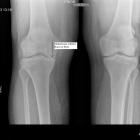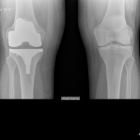A Knee Replacement is a surgical procedure performed to treat chronic knee pain usually due to arthritis.
Knee arthritis is a condition where the smooth articular cartilage lining of the knee wears away. Eventually this exposes the underlying bone. Knee arthritis is associated with knee pain, stiffness and limitation of function.
Who should have a Knee replacement?
A knee replacement is usually performed on someone over 60 with arthritis of the knee that is not able to be treated with other therapies. Most patients try some or all of physiotherapy, medication or injections into the knee prior to contemplating knee replacement. In patients less than 60 years of age knee replacement may still be performed if the symptoms are severe enough but there is increased risk.
Before Surgery
Prior to knee replacement most patients will require a medical assessment by a physician. This allows detection and management of medical issues. The physician will usually be available at the time of the hospitalisation to help manage any medical issues.
Some blood tests will be required.
“Prehab” – Also prior to surgery “prehab” or preparation and exercise prior to surgery make a big difference to recovery. You will usually be seeing a physiotherapist a number of times before surgery to work on range of motion and strengthening. You will also learn how to use walking aids (usually crutches).
The pre-operative work makes recovering after surgery easier and faster.
The Surgery
Knee replacement requires a large slightly curved incision on the front of the knee. Through this incision the arthritic surfaces of the knee are removed and the knee replacement inserted.
After The Surgery
The most important aspect of knee replacement aftercare for the patient is early mobilisation. A physiotherapist will advise you on exercises to do in bed and also assist with beginning to walk again. Mobilisation after a knee replacement is difficult especially at first and requires lots of hard work from the patient. The goals are safe walking, usually with an aid (crutches, walker) and good knee bend (at least 90 degrees prior to discharge home).
Most patients will achieve the ability to safely walk (with an aid) and good knee bend in a few days. For those who have difficulty a stay in a rehabilitation ward may be appropriate. Patients who prepare well usually have a faster recovery and can avoid the rehabilitation ward. Shorter stays in hospital lead to better results and less risk of complications.
Recovery
The recovery time after knee replacement is variable. Some patients have very fast recoveries and others take longer. Most patients will be able to manage crutches and be discharged home from hospital after a few days. Some patients will need longer. By 6 weeks most patients are mobilising well and beginning to return towards normal function, some however will still have significant pain and stiffness at that time. By 6 months 95% of people are doing well.
Physiotherapy before and after knee replacement is very important. Physiotherapy helps with walking and pain relief and is crucially important with regards to bending the knee.
The Results
Most people do well after knee replacement, but certainly not all. There are a number of risks involved with the surgery, these will be explained in detail should you elect to proceed with a knee replacement.
In Australia the National Joint Replacement Registry collects data on all knee replacements performed. Their data shows that after 10 years, 95% of knee replacements are still functioning. This means that 5 in 100 knees will require more surgery in the first 10 years. This usually involves revising the knee replacement to another implant. Reasons for this include infection, failure of implants, pain, etc.
A knee replacement is not a normal knee and many patients feel that the knee feels different to a normal knee. Clicks and noises from knee replacements are common and unless painful rarely a problem. Most patients have a patch of numbness near the knee, usually this causes no problems.
Knee replacements can be performed in patients under 60 years where the symptoms warrant. The failure rate of knee replacement in patients under 55 is three times the rate of failure in patients over 65.
Knee replacement is not appropriate in young patients who wish to perform heavy work.



